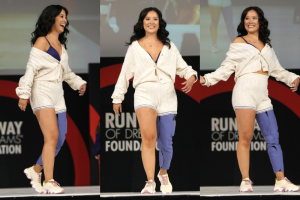
Ever since my injury, my biggest goal has always been to regain my independence. I wanted my old life back. I wanted to get around independently without assistance. To travel again. To be able to return to work after my stroke.
I wasn’t aware of many young people who had strokes, and I wanted to just be like everyone else my age—living in new cities and launching their post-grad careers. I perceived my mobility limitations to be a barrier to my entering the workplace, so I first determined what skills I was lacking that would help me get back to the workplace. I didn’t feel ready, but a part of me thought, will I ever truly feel prepared to go back to work, and should I just go ahead and take the leap anyway, even if it scares me?
Returning to Work After a Stroke
Because I am persistent (read: stubborn :P), I decided I wanted to start working after trialing a handful of volunteer opportunities and part-time jobs in my community. A little under two years after my stroke, I received my first full-time job offer as a junior reinsurance underwriter for a company with headquarters near my parents’ home.
While the office was near, I couldn’t drive a car due to vision loss, so I was determined to find a way to get to the office independently. I didn’t want to have to rely on others to drive me to the office every day. So, I set a goal: learn to commute to my office in the next town over. It was too far to walk, so my options were limited. I would have to learn how to take the train from my local station.
A Big Step Up
Luckily for me, the train station in my town is close enough to walk to, so I began by walking 15 minutes to my town’s train station with my dad, and he would then help me manage the big step up onto the train from the platform when it arrived. The few big steps that I needed to take to climb up onto the train were a challenge, but I was determined to find a way to do it on my own.
Every morning I would walk to the station with my dad, and we would practice. I would use my unaffected hand to grab onto the railing and propel myself up to the first step. From there, the rest was fairly easy, but the more I practiced the more comfortable I felt with doing it on my own.
Eventually, I got to the point where I didn’t need any more help to grab onto the railing and take the big step up onto the train. Like anything in life, the more you practice, the more comfortable and confident you feel in your ability to do it.
After a few months, I no longer needed my dad to accompany me on the walk to the train station in the morning (which was good for him, because he also had to get to work himself in the morning).
Moving Out and Living Independently
A couple of years after that, I decided I wanted to switch careers and began a new path in luxury fashion. When I accepted this role, it was in an office about an hour’s drive from my parent’s house, so it didn’t make much sense for me to commute so far when I couldn’t drive. Ubers were expensive to the office, and there was no direct train line to get me where I needed to go.
At this point, I decided I was going to take my second major leap of faith and move out. I found a nice apartment complex near my office, and my application to move in was accepted. Shortly after, I made the move to Helmetta, NJ, where I got to experience living independently again. It was only a quick Uber ride from my apartment to the office, and I felt good. I had my agency back.
I enjoyed living on my own so much, but my only complaint was that I was in the middle of nowhere, New Jersey. I wanted to be where the action was, in the city where everything was more accessible and easier to navigate, and most importantly, where my network of family and friends was. Since I was so far away from everyone else, I hardly saw my friends unless I went home to my parent’s for the weekend and made a day trip into the city.
City Living: Relocating to NYC
I managed to get relocated to the NYC office for my job, and so my next step was to find a place to live. As I began the apartment search, there were a few non-negotiables for living I had identified. 1) I needed to be centrally located and close to public transit so I could get around the city on my own, 2) I needed an apartment on the ground floor or in a building with an elevator so I wouldn’t be forced to struggle up to my 4th floor walk up, and 3) bonus points if the laundry was in-unit or else easily accessible to me.
Surprisingly, it’s quite hard to find an apartment that fits all of these requirements. While New York City is accessible, many parts of the city do not comply or are not designed for people with disabilities. Luckily for me, it seemed that most people weren’t interested in living on the ground floor of an apartment, so I was able to find spaces that fit most of my needs.
I fell in love with a small one-bedroom apartment in the Upper West Side of Manhattan – it was on the ground floor, had trash disposal nearby, and the laundry machines were 10 steps down the hall in my building. There’s little that could have made it better. I signed the lease, eager to begin my life in the big city.
Once I secured my housing, the next step was learning about my neighborhood and figuring out how I would commute to work every day. I quickly mapped out my Subway route and also discovered that I could easily walk to the office by cutting through Central Park.
Walking to Work With My Cionic Neural Sleeve
Walking is my favorite form of exercise, and I try to do it as much as I can, so walking to and from work every day quickly became a new habit and a great way to start my day. With my Neural Sleeve, I have been able to get myself to work, all while experiencing the beauty of the changing seasons in Central Park. It blows my mind that I live in such an amazing city with so much to see and do. I wouldn’t be able to do any of it without my Neural Sleeve.




